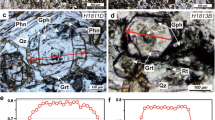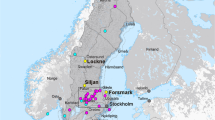Abstract
Carbonaceous material present in ancient rocks can be used as an indicator of life during the time the rocks were formed. In particular, evidence for the existence of life more than 3,800 million years ago might come from mineral associations between apatite and graphite in rocks from southern West Greenland1,2,3,4,5,6,7. However, this interpretation is partly based on the assumption that the graphite was formed at the same time as the host rocks, an assumption that has been difficult to prove2,3,4,5,6,7. Here we investigate the origins of poorly crystalline graphite associated with apatite in metamorphosed banded iron formations from northern Canada that are 3,750 to 4,280 million years old8,9,10,11. We measured average δ13Cgraphite values of −22.8±1.9‰ (1σ), similar to values from West Greenland sedimentary rocks of comparable age1,3,5,6,7,12,13,14, and that point to a biological source for this carbon. Our microscopic and spectroscopic analyses suggest, however, that the graphite experienced much lower temperatures than the host rocks during metamorphism. We conclude that the poorly crystalline graphite in these rocks was deposited by fluids after peak metamorphism of the banded iron formations. We suggest that the occurrence of carbonaceous material with low δ13C values in Eoarchaean rocks cannot be used to indicate the presence of a microbial biosphere on the earliest Earth unless the syngeneity of the carbonaceous material in the host rock can be confirmed.
This is a preview of subscription content, access via your institution
Access options
Subscribe to this journal
Receive 12 print issues and online access
$259.00 per year
only $21.58 per issue
Buy this article
- Purchase on Springer Link
- Instant access to full article PDF
Prices may be subject to local taxes which are calculated during checkout



Similar content being viewed by others
References
Mojzsis, S. J. et al. Evidence for life on Earth before 3,800 million years ago. Nature 384, 55–59 (1996).
Lepland, A., Arrhenius, G. & Cornell, D. Apatite in early Archean Isua supracrustal rocks, southern West Greenland: Its origin, association with graphite and potential as a biomarker. Precambr. Res. 118, 221–241 (2002).
McKeegan, K. D., Kudryavtsev, A. B. & Schopf, J. W. Raman and ion microscopic imagery of graphitic inclusions in apatite from older than 3,830 Ma Akilia Supracrustal rocks, west Greenland. Geology 35, 591–594 (2007).
Papineau, D. et al. Ancient graphite in the Eoarchean quartz-pyroxene rocks from Akilia in southern West Greenland I: Petrographic and spectroscopic characteristics. Geochim. Cosmochim. Acta 74, 5862–5883 (2010).
Papineau, D. et al. Ancient graphite in the Eoarchean quartz-pyroxene rocks from Akilia in southern West Greenland II: Isotopic and chemical compositions and comparison with Paleoproterozoic banded iron formations. Geochim. Cosmochim. Acta 74, 5884–5905 (2010).
Van Zuilen, M. A., Lepland, A. & Arrhenius, G. Reassessing the evidence for the earliest traces of life. Nature 418, 627–630 (2002).
Van Zuilen, M. A. et al. Graphite and carbonates in the 3.8 Ga old Isua Supracrustal Belt, southern West Greenland. Precambr. Res. 126, 331–348 (2003).
Cates, N. L. & Mojzsis, S. J. Pre-3750 Ma supracrustal rocks from the Nuvvuagittuq supracrustal belt, northern Québec. Earth Planet. Sci. Lett. 255, 9–21 (2007).
David, J., Godin, L., Stevenson, R., O’Neil, J. & Francis, D. U–Pb ages (3.8–2.7 Ga) and Nd isotope data from the newly identified Eoarchean Nuvvuagittuq supracrustal belt, Superior Craton, Canada. Geol. Soc. Am. Bull. 106, 86–104 (2009).
O’Neil, J. et al. Earth’s Oldest RocksVol. 15, 219–250 (Elsevier, 2007).
O’Neil, J., Carlson, R. W., Francis, D. & Stevenson, R. K. Neodymium-142 evidence for Hadean mafic crust. Science 321, 1828–1831 (2008).
Rosing, M. T. 13C-depleted carbon microparticles in >3700-Ma sea-floor sedimentary rocks from West Greenland. Science 283, 674–676 (1999).
Schidlowski, M., Appel, P. W. U., Eichmann, R. & Junge, C. E. Carbon isotope geochemistry of the 3.7×109 yr old Isua sediments, West Greenland: implications for the Archaean carbon and oxygen cycles. Geochim. Cosmochim. Acta 43, 189–200 (1979).
Ueno, Y., Yurimoto, H., Yoshioka, H., Komiya, T. & Maruyama, S. Ion microprobe analyis of graphite from ca. 3.8 Gyr metasediments, Isua supracrustal belt, West Greenland: Relationship between metamorphism and carbon isotopic composition. Geochim. Cosmochim. Acta 66, 1257–1268 (2002).
Kappler, A., Pasquero, C., Konhauser, K. O. & Newman, D. K. Deposition of banded iron formations by anoxygenic phototrophic Fe(II)-oxidizing bacteria. Geology 33, 865–868 (2005).
Konhauser, K. O. et al. Could bacteria have formed the Precambrian banded iron formations? Geology 30, 1079–1082 (2002).
Widdel, F. et al. Ferrous iron oxidation by anoxygenic phototrophic bacteria. Nature 362, 834–836 (1993).
Van Cappellen, P. & Berner, R. A. A mathematical model for the early diagenesis of phosphorus and fluorine in marine sediments: apatite precipitation. Am. J. Sci. 288, 289–333 (1988).
David, J., Parent, M., Stevenson, R., Nadeau, P. & Godin, L. Ministère des Ressources Naturelles du Québec, DV 2002–10.
Cates, N. L. & Mojzsis, S. J. Metamorphic zircon, trace elements and Neoarchean metamorphism in the ca. 3.75 Ga Nuvvuagittuq supracrustal belt, Québec (Canada). Chem. Geol. 261, 98–113 (2009).
Luque, F. J., Pasteris, J. D., Wopenka, B., Rodas, M. & Barrenechea, J. F. Natural fluid-deposited graphite: Mineralogical characteristics and mechanisms of formation. Am. J. Sci. 298, 471–498 (1998).
Wopenka, B. & Pasteris, J. D. Structural characterization of kerogens to granulite-facies graphite: Applicability of Raman microprobe spectroscopy. Am. Mineral. 78, 533–557 (1993).
Bernard, S. et al. XANES, Raman and XRD study of anthracene-based cokes and saccharose-based chars submitted to high-temperature pyrolysis. Carbon 48, 2506–2516 (2010).
Beyssac, O., Goffe, B., Chopin, C. & Rouzaud, J. N. Raman spectra of carbonaceous material in metasediments: A new geothermometer. J. Metamorphic Geol. 20, 859–871 (2002).
Gole, M. J. Low-temperature retrograde minerals in metamorphosed Archean banded iron formations, Western Australia. Can. Mineral. 18, 205–214 (1980).
Reyes, A. G., Grapes, R. & Clemente, V. C. Fluid-Rock Interaction at the Magmatic-Hydrothermal Interface of the Mount Cagua Geothermal System Vol. 10, 197–222 (Society of Economic Geologists Special Publication, 2003).
French, B. Stability relations of siderite (FeCO3) in the system Fe–C–O. Am. J. Sci. 271, 37–78 (1971).
Feely, R. A., Trefry, J. H., Lebon, G. T. & German, C. R. The relationship between P/Fe and V/Fe ratios in hydrothermal precipitates and dissolved phosphate in seawater. Geophys. Res. Lett. 25, 2253–2256 (1998).
Rietmeijer, F. J. M. Mixed layering in disordered Sri Lanka graphite. Carbon 29, 669–675 (1991).
Cody, G. D. et al. Organic thermometry for chondritic parent bodies. Earth Planet. Sci. Lett. 272, 446–455 (2008).
Acknowledgements
We thank the municipality of Inukjuak and the Pituvik Landholding Corporation for permission to work on their territory and M. Carroll for his support. We acknowledge funding from the NASA Exobiology and Evolutionary Biology Program (Grant No. NNX08AO16G), the NASA Astrobiology Institute (Grant No. NNA04CC09A), the W.M. Keck Foundation, the Geophysical Laboratory of the Carnegie Institution of Washington, Carnegie of Canada, the Naval Research Laboratory, the NRC Research Associateship Program, Boston College, and the FQRNT. Some data was acquired at beamline 5.3.2.2 at the ALS, which is supported by the Director of the Office of Science, Department of Energy (Contract No. DEAC0205CH11231).
Author information
Authors and Affiliations
Contributions
The research was spearheaded by D.P. Correlated micro-analyses were performed by D.P. and B.T.D. The manuscript was written by D.P. and B.T.D. with important contributions from all co-authors.
Corresponding author
Ethics declarations
Competing interests
The authors declare no competing financial interests.
Supplementary information
Supplementary Information
Supplementary Information (PDF 5093 kb)
Rights and permissions
About this article
Cite this article
Papineau, D., De Gregorio, B., Cody, G. et al. Young poorly crystalline graphite in the >3.8-Gyr-old Nuvvuagittuq banded iron formation. Nature Geosci 4, 376–379 (2011). https://doi.org/10.1038/ngeo1155
Received:
Accepted:
Published:
Issue Date:
DOI: https://doi.org/10.1038/ngeo1155
This article is cited by
-
Evidence for early life in Earth’s oldest hydrothermal vent precipitates
Nature (2017)
-
Early trace of life from 3.95 Ga sedimentary rocks in Labrador, Canada
Nature (2017)
-
Progress and perspective on frontiers of geobiology
Science China Earth Sciences (2014)



